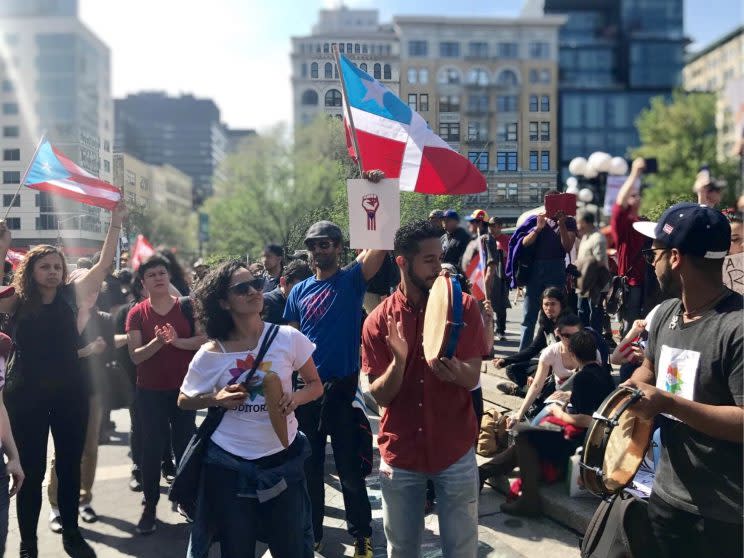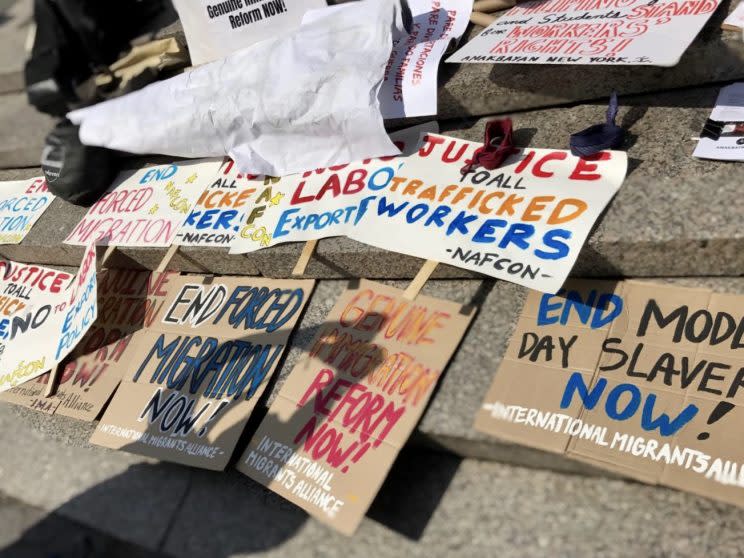Opposition to Trump unites May Day protesters

As soon as Monica Rivera Rosado saw on Facebook that members of New York City’s Puerto Rican community were rallying in solidarity with thousands of protesters in San Juan Monday afternoon, she dropped what she was doing and rushed over to Union Square.
“I’ve been seeing all the posts of people marching throughout the streets in Puerto Rico and you know, I miss it. I want to be there,” said Rosado, who grew up in the island territory but is currently getting her master’s degree in environmental education at New York University. “I definitely support the student movement, and I would’ve loved to be involved in their fight right now.”
Mounting frustration over Puerto Rico’s crippling debt crisis and expected austerity measures reached a timely boiling point on Monday, as workers in cities around the country and the globe took to the streets in honor of May Day, or International Workers’ Day.
By the time Rosado arrived, representatives from a variety of countries and causes had descended upon Union Square in a mass of chants, signs, and flags. Amid the crowd, the familiar rhythm of tambourines and drums quickly led her to the small but enthusiastic Puerto Rican contingent.
“We’re a very loud culture, definitely people with instruments and making noise,” Rosado said. “It definitely [feels] like home, like I was with my people fighting for what we believe in and supporting our strike back home.”

Since May 1, 1886, when tens of thousands of workers from across Chicago walked off the job to participate in protests that ended in violent clashes with police, so-called May Day celebrations (in the United States, at least) have attracted a blend of organizations and interests, including socialists, anarchists, union organizers, worker’s rights advocates, and immigration reformers.
Monday’s events in New York were no different, as a diverse lineup of organizers took turns speaking out in a variety of languages against everything from unfair treatment of immigrant workers to the NYPD’s controversial “broken windows” policing strategy to the concept of law enforcement and government in general.
What was different, however, was that beneath the vast web of interests and, sometimes seemingly conflicting messages was the unanimous opposition to a new, common enemy: President Donald Trump.
“It’s always been a collective event,” said Leilani Dowell, an organizer with the New York City-based Worker’s World party, a socialist organization dating back to 1959.

“We’ve come out here every year for May Day since 2006, when the huge immigrant uprising happened,” she said, referring to massive Latino-led protests against proposed changes to federal immigration policy. “But we think it’s all the more important this year given Trump’s attacks on migrants and actually, all workers in general.”
Despite increased interest in this year’s strike, as well as the addition of new advocacy groups that have emerged in the wake of Trump’s election, Dowell said that the turnout at Union Square Monday afternoon was comparable to years passed. However, she suggested that the same policies driving new interest in the annual protests — specifically, the Trump administration’s crackdown on illegal immigration — have likely also discouraged many others from participating.
“I think there’s a lot of fear,” she said.
George Zacatelco, a pastry chef and U.S.-born son of Mexican immigrants, affirmed Dowell’s theory.
Zacatelco said he took the day off to rally in solidarity with the Cosecha movement, a young immigrant rights organization created in response to Trump, but he had a hard time convincing other employees at the Harlem bakery where he works to do the same.
“Some of them are not here because they’re undocumented and they’re afraid to come out, especially with this whole new immigration policy,” he said.
Of course, that’s not the only reason why most of his coworkers declined to join in Monday’s strike.
“It’s pretty hard being a working-class person, you have bills to pay so not a lot of people can be here,” he said. “In other countries, May 1st is … you get the day off. But not here.”
Read more from Yahoo News:



